Twitter: the most popular social media channel for journalists
As a team, we use it to follow the news and live trends in the explore tab, we use #journorequest to communicate directly with journalists where we can offer them stories at quick turnarounds, we use #PRrequests for our own content, generally build relationships via direct messaging with influencers and experts to gain quotes for our content and utilise it to help with link building.
These are our bread and butter uses but, how else can we use it when it comes to trending topics?
News and trends
News and trends can be difficult to keep up with, especially with today’s frantic, nonstop drive of breaking news and scandal. So even the explore page and trending topics can be a lot to digest. There are a great number of social listening tools where you can delve deep into the trends and conversations on social media and they’re great – if you have the budget!
For a quick snapshot to feed your ideas and get an understanding of what people are talking about across the whole world, sites like Trends Map and Trends24 are useful.
With Trends Map, you can quickly look around the map of the world to see what is trending in each region. Without the paid version, data is slightly restricted but it’s still helpful.
With Trends24 you can see what has been trending each hour of the day for 400 locations across the world. The site explains that the trends in the sidebar on Twitter are always changing so we might miss trends that evolve over the day but with Trends24 we can see the view of the day with the timeline that they have to really capture how stories and trends have developed and evolved.
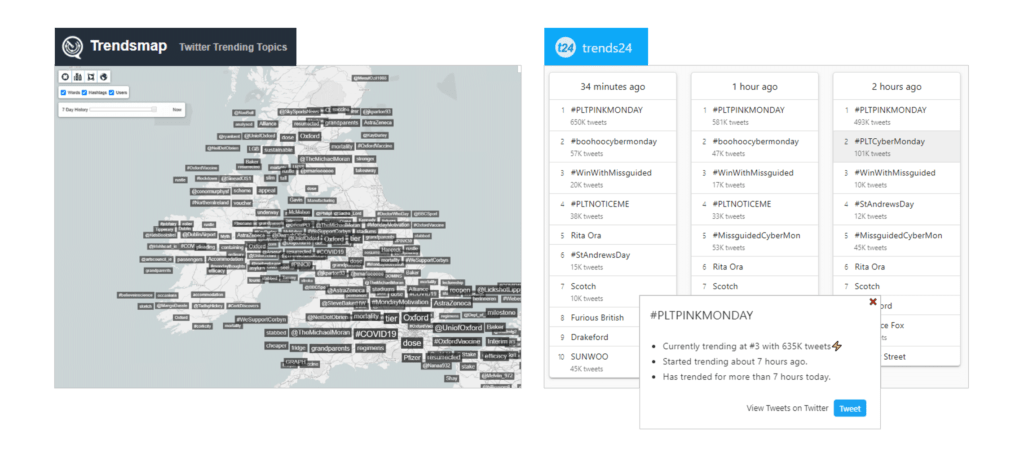
Twitter Lists
Another way to deal with more niche discussions and trends is Twitter Lists on the app – an often under-utilised but helpful way of keeping track of niche topics. It’s a great place to segment down experts from various fields like politics or sports, digital PR, data etc. Rather than following thousands of people and getting drowned in a busy timeline, adding people to lists you can click into and just follow is really helpful. For example, I’ve created a list full of data journalists and data-based accounts that tweet about the latest data visualisations and designs from their publications – this not only gives me a direct look at what the journalists and publications are covering, but also design inspiration and potential data sources to use in our own campaigns.
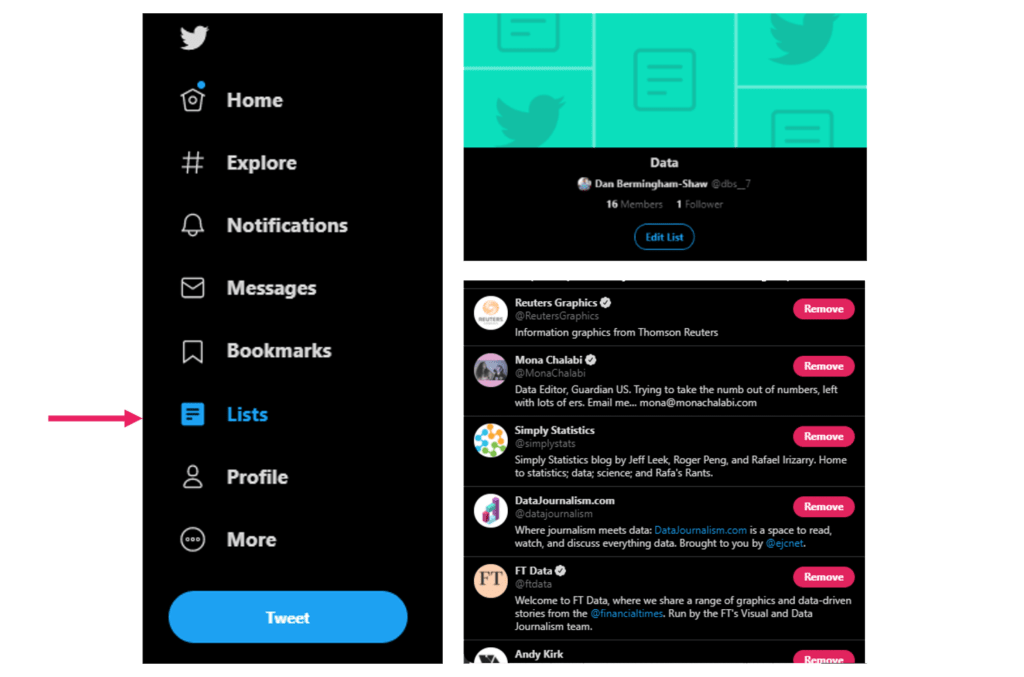
Social Blade
This is good for sourcing your own data as it covers Twitter data as well as pretty much every other social media channel and is regularly cited as a source for big publications like the New York Times, Buzzfeed and Yahoo. Social Blade tracks social media statistics and analytics for Twitter, Instagram, YouTube, TikTok, and more. You can see the details about every public account on each platform and therefore spot trends in the followers of each account as well as how their posts rank against other accounts. For example, a screenshot of Joe Wicks the body coach’s Twitter account shows he had a huge peak of new followers back in March during the first national lockdown when he started doing his home PE workouts for kids and this gained a lot of news coverage. You can spot those sorts of trends really easily just by typing in the username on the platform.
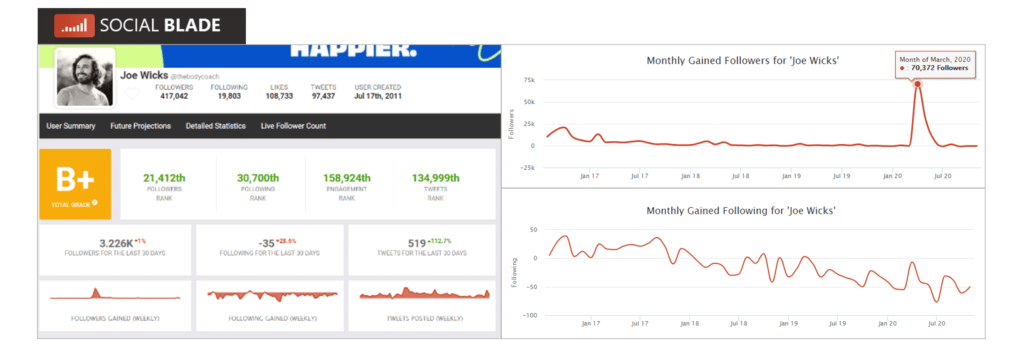
Depending on what social channel you’re looking at, the data points will change – for example, with YouTube accounts you can even see their estimated monthly and yearly earnings predicted. So, there’s a wealth of statistical information that can feed into campaigns on social creators including followers, subscribers, engagement rates, video views etc. These sorts of stats could be put together in data rankings for campaigns, or even just used as supportive figures alongside your story.
It’s clear to see Twitter has a wealth of uses, features and aligned sites that help to draw out loads of interesting information and help get your stories picked up quickly and by the right people.
Tik Tok: an emerging platform for journalists and digital PRs
TikTok has huge potential value as it emerges as a place where internet and cultural trends are born, especially throughout this pandemic. It’s an incredible place to spot trends and creativity online and I believe we’ll see more activity among journalists so I’ll be talking through some examples of where journalism is being helped by TikTok activity and why it may be a great idea for digital PRs and journalists to utilise.
Journalists who are on it absolutely love it and some have done incredible jobs of getting their news in front of a younger audience. We know how TikTok skews to a younger audience with two-thirds of its users being under the age of 30 and 60% of its users being between the age of 16 and 24. We will likely see a lot more jumping onto the platform in the future. Dave Jorgenson from the Washington Post famously quoted:
What happens on TikTok today will be driving global cultural conversation tomorrow.
To demonstrate, 80 million posts with #TikTok, 4.3 million #TikTokdance and 7 million with #TikTokmemes – and these are from Instagram! So, this demonstrates what happens on TikTok doesn’t stay on TikTok but is shared far and wide and creates cultural trends and narratives way beyond just the platform.
Finding trends on TikTok
Apart from spending time on the ‘for you’ page – the initial page you see when you land on the app which is dictated by the algorithm and your activity on each video.
You also have the discover tab to see all the latest trending hashtags, videos, brand and influencer campaigns, dances, music tracks and everything that’s trending at that time, along with the number of cumulative views the video has on that hashtag.
As with most social platforms, hashtags are a great way to find what you’re looking for quickly.
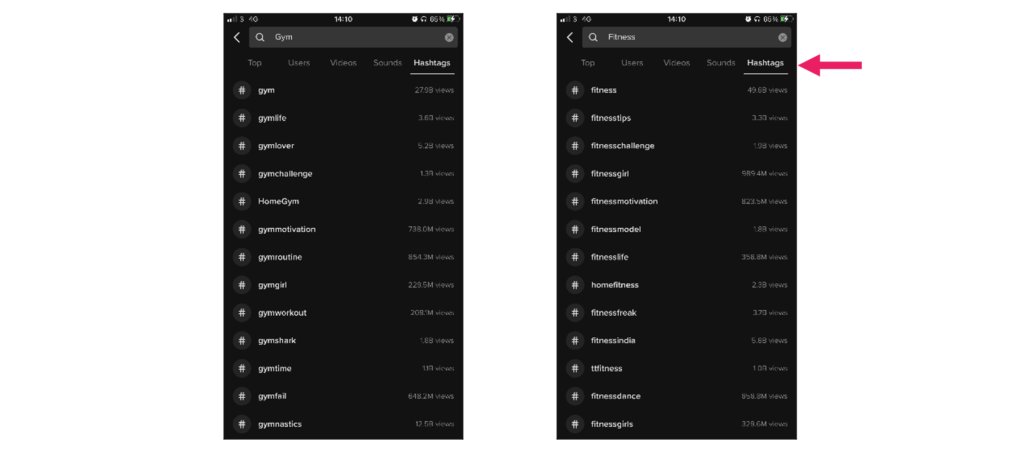
Using gym and fitness as an example, the data points could potentially be used to create some sort of ranking of the most popular exercises.
Journalists from the BBC NBC, CNN and Washington Post are just a few who are highly active on the platform.
TikTok is fast emerging as more than just a highly addictive social channel, with its videos permeating other social platforms and the huge potential for data and creative inspiration.
Reddit: ‘the front page of the internet’
Reddit is one of the first places I go when I’m trying to kick off an idea. It’s so easy to find passionate and knowledgeable people discussing topics, who have experience and are asking questions you may not even have thought of yet. It’s one of the biggest websites in the world and in the year in review they found that users average 21 billion screen views a month. So, there’s a huge amount of people ready to give you their views on every topic under the sun. I’m going to talk you through how I find it can be used for idea and campaign inspiration, as well as data sources.
In a recent interview, the VP and President of Global Advertising for Reddit, explained how Reddit embodies what’s going on in society and is therefore a perfect place for people to go to understand emerging trends among communities. Communities grow based on trends happening in society so staying up to date by reading the sentiment and questions from subreddits is important. As a brand or someone working to create content for a client, you want to be as authentic and genuinely interested as possible when you engage otherwise the community isn’t going to respond as positively.
Reddit etiquette
In the interview mentioned, the VP likens it to walking into a dinner party – at first you walk in, you listen and learn the topics being discussed, then you slowly but authentically get involved in the conversation. You then stick around for the back and forth and participate naturally in that conversation. So, explore, contribute, and ask questions of communities to gain a greater understanding of what content people want and need. Even feel free to ask for feedback from them to get honest, open opinions of where your ideas can improve.
Research that Reddit did themselves found that 72% of Redditers say they do want brands to contribute and participate in communities so there is an appetite for it if you want to comment and get involved, as long as you are genuinely interested in trying to learn something new.
Navigating Reddit
The first thing you see when you go onto the front page of Reddit is a collection of the best, most recent posts from a range of subreddits, and you can filter them and search at the top for whatever niche you want to find and explore.
Search inside that specific subreddit for queries and phrases such as ‘how to’ to see posts with questions to feed your ideas. Click into them to scour the comments and you’ll see Reddit suggests other similar communities on the right-hand tab.
Use the questions asked and suggestions given to think of where knowledge gaps might be and what questions might still need answering – perhaps there are trends in what is being posted and the answers could be developed into something even more helpful than what is being provided here, with a little bit more research and an ideation session.
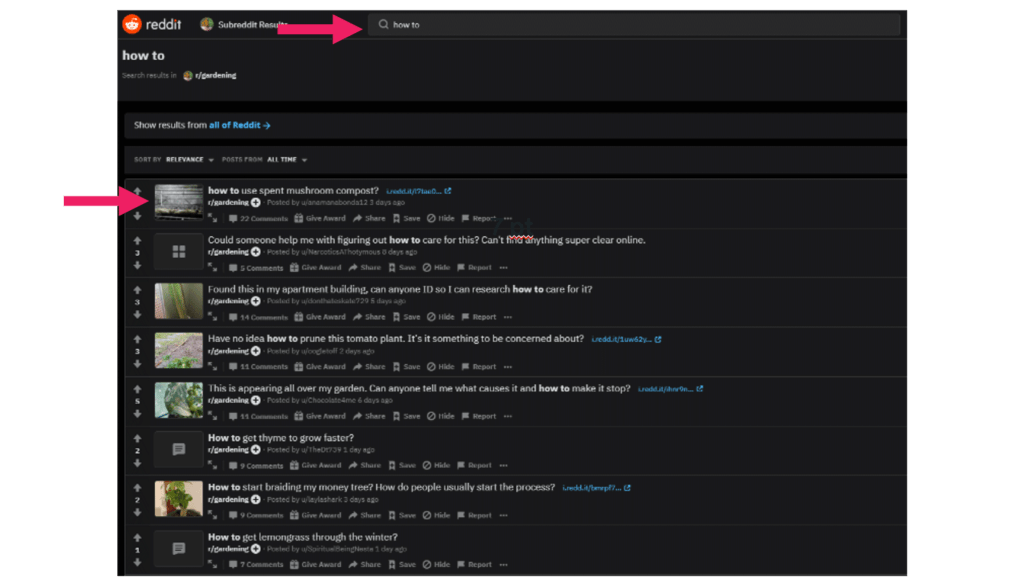
Data is beautiful
One notable mention on Reddit is ‘Data is beautiful’ which is one of my favourite places to search for inspiration on how to visualise content with creative interpretations of data from Reddit users and organisations.
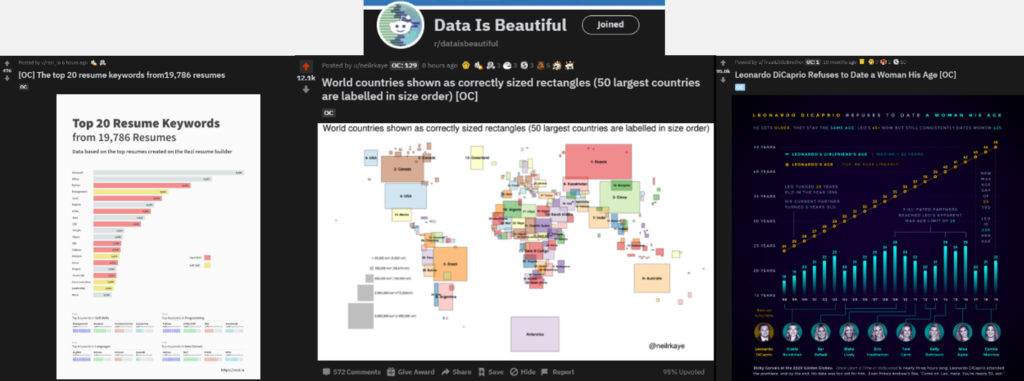
Subreddit stats
A really helpful site is subreddit stats, which records the growth of subreddits across the whole of Reddit with daily, weekly, monthly and yearly growth stats for them along with comments and uploads etc.. You could use this data to compare subreddits and ask which ones had the most traction through certain global or local events such as lockdown or coronavirus.
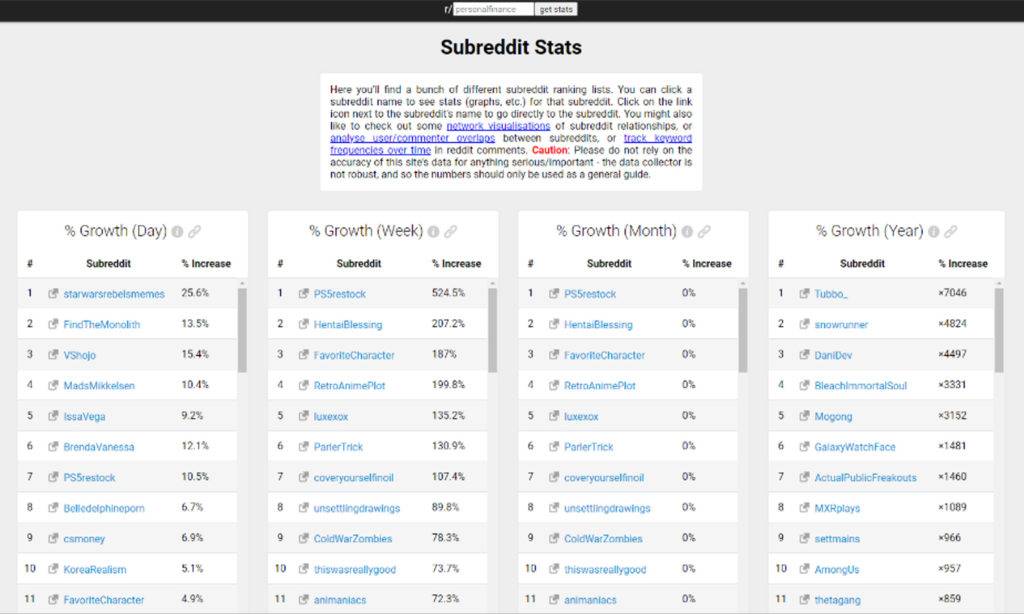
Tapping into both newbie questions and expert opinions from niche Reddit communities is a sure-fire way to build out and back up any idea – there is truly a mountain of knowledge and great people to connect with to discuss it.
Instagram: quick and easy data pulling
Instagram isn’t the first place that I would necessarily search for content inspiration myself, but there are some really good uses for it that I will outline here. It does have over a billion active users and 500 million using the platform every day so there’s a lot of posts to filter through, which means you need to know to look in the right places.
We can use Instagram hashtags and post data to create rankings and content. So much creative content is based on this data to determine what is the most popular thing at the time – whether it be most popular cities or holiday hotspots, Scottish foods etc. – these are all super easy to find and create.
Using hashtags for data trends
If you are using the data from the hashtags, it just takes a simple search in the Instagram app or desktop page. If I’m putting together a list of the most popular cities and I want to use the hashtag data then just search for the hashtag Rome as an example, it pops up 26 million posts and Instagram labels that for you so it’s nice and easy.
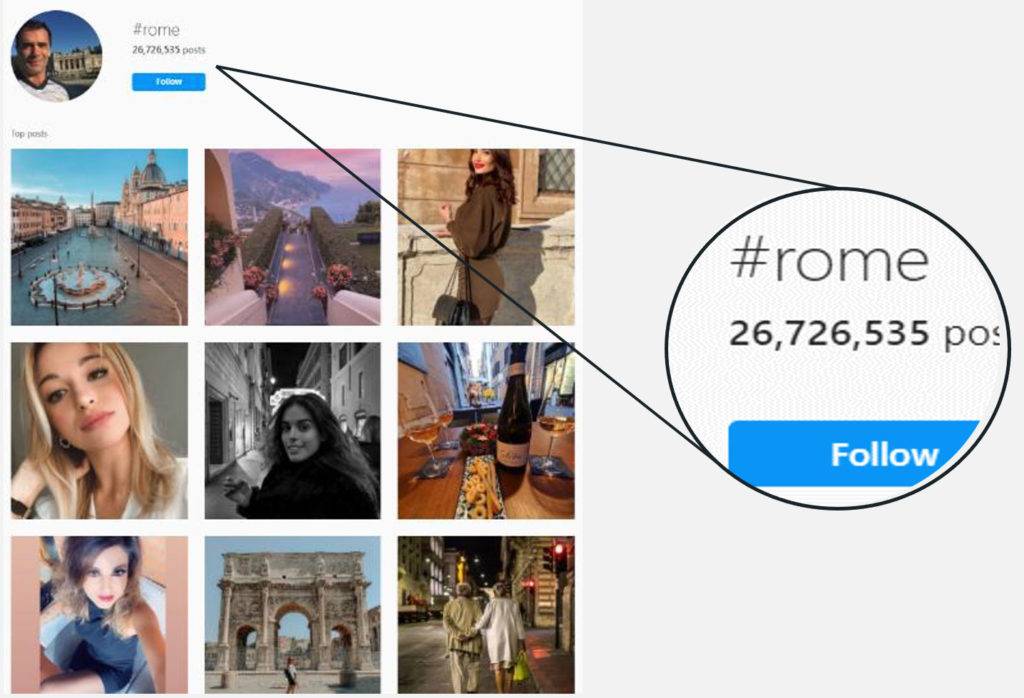
Digging deeper with post data
However, you might want to use the number of posts taken at a particular place and tagged as such. In this case, people who have gone to Rome and used geo-tag to tag their images in the city. This is a little bit tricky to find because they don’t display on the page (I’m sure there are ways clever developers can scrape the site using an API but we’ll keep it simple, quick and easy). Go onto the desktop page for the geo-tag location, right click and view the page source and then if you just search the page source for the source code for Instagram photos that will take you to the number of posts!
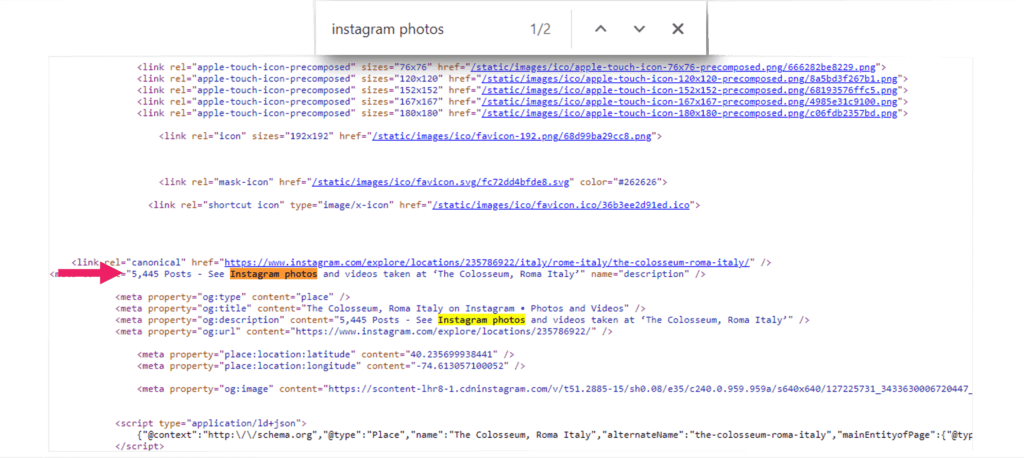
As one of our own recent examples from the digital PR team, for our airline client Icelandair – the team saw the popularity of Instagram hashtags in different landmarks around the world and used the available social media data as well as customer reviews, population stats, and also search volume to create a list of some of the world wonders, highlighting the locations that are the most ‘Instagramable.’
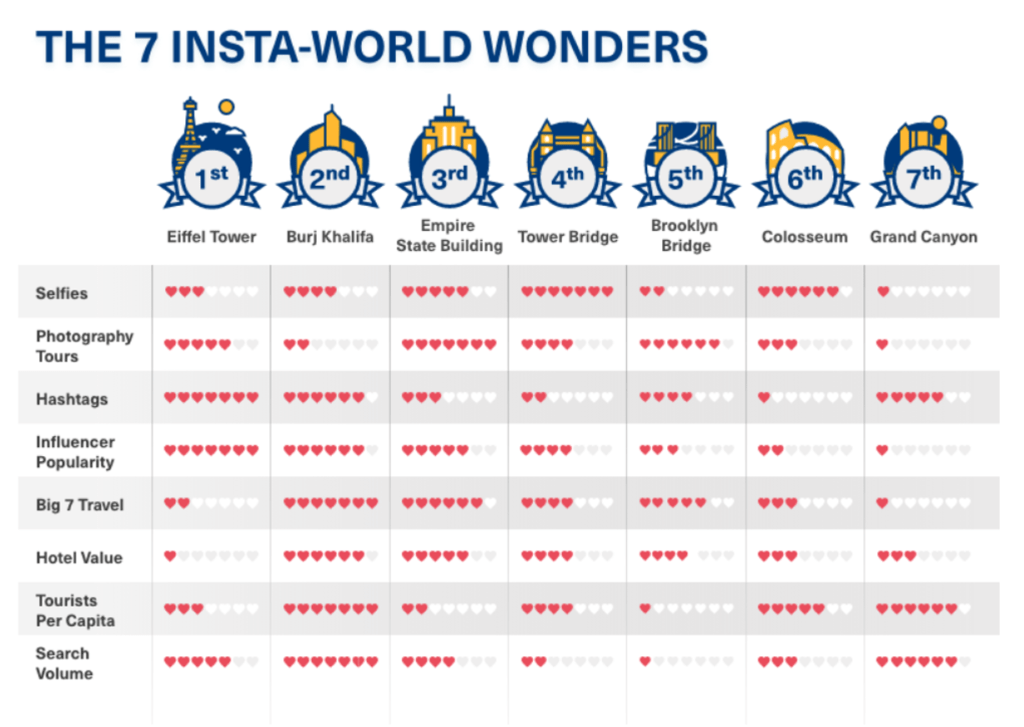
Once you know where to look, Instagram can open up a great deal of trends data so be sure not to overlook this platform.
YouTube: the beast of social media
The go-to video platform with over 1 billion hours of views a day – which highlights how massive a beast YouTube is. Three billion searches per month make it the number two search engine in the world and its popularity and massive usage makes it the perfect place to pull trends and data from.
Google trends
Google trends allows you to search for YouTube searches which will help you see what videos people are searching for, what are the breakout keywords being searched and where exactly those searches are coming form. You can export this data as well as the related queries to expand the search of trending topics and keywords that are being searched on YouTube.
YouTube trends
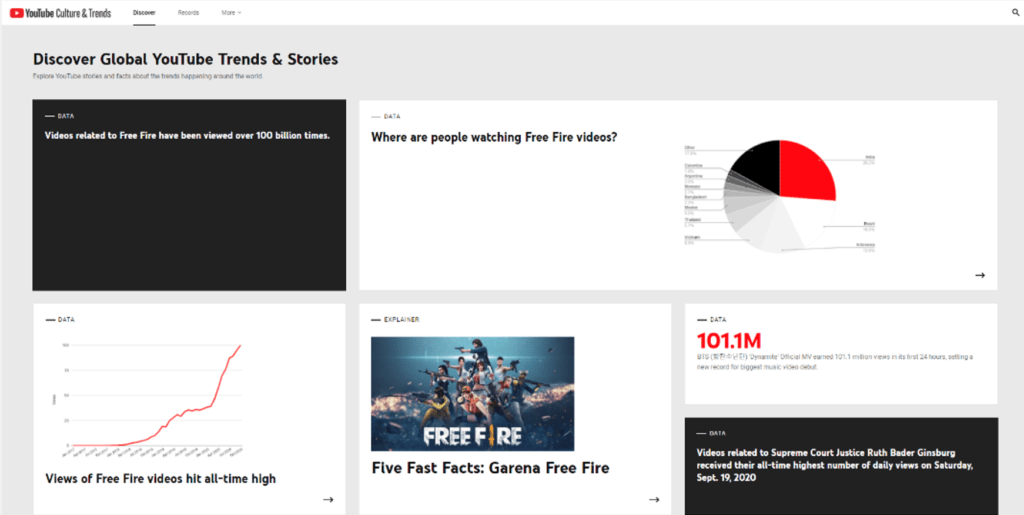
YouTube also has its very own YouTube trends page where you can go to discover the latest, popular videos and searches on the platform. You can learn what’s driving popular culture with stories exploring comment trends. YouTube says that the pages highlight the unique trends developing organically within the YouTube community. Ultimately, an ideal place to go to see a concentrated cross section of the daily conversation that unfolds on YouTube.
They also have a news coverage section, just to give you an idea about how news publications are using the data and covering it. This can help you to tailor your own pictures to journalists when reaching out with this sort of data as well.
As a hybrid social platform and search engine, it is no wonder YouTube holds the value it does when it comes to trends and searches and this remains invaluable for feeding campaigns.
Twitch: the live-streaming platform to watch
A rising video-based social platform, much smaller than YouTube but interesting to take a look at – Twitch is a live streaming platform focused on video games but can feature any sort of video like people talking to friends, political news and coverage has been quite popular, especially during the election and since the pandemic, their most popular category has been ‘just chatting’ which is literally just a chance for people to get on the stream and chat.
The pandemic has caused usage to rise, with 1.6 billion hours of videos watched in October 2020, so this highlights the big upward trend that it is riding at the moment and warrants why it should be paid attention to. Lucky for us there are sites to monitor these trends and utilise the data.
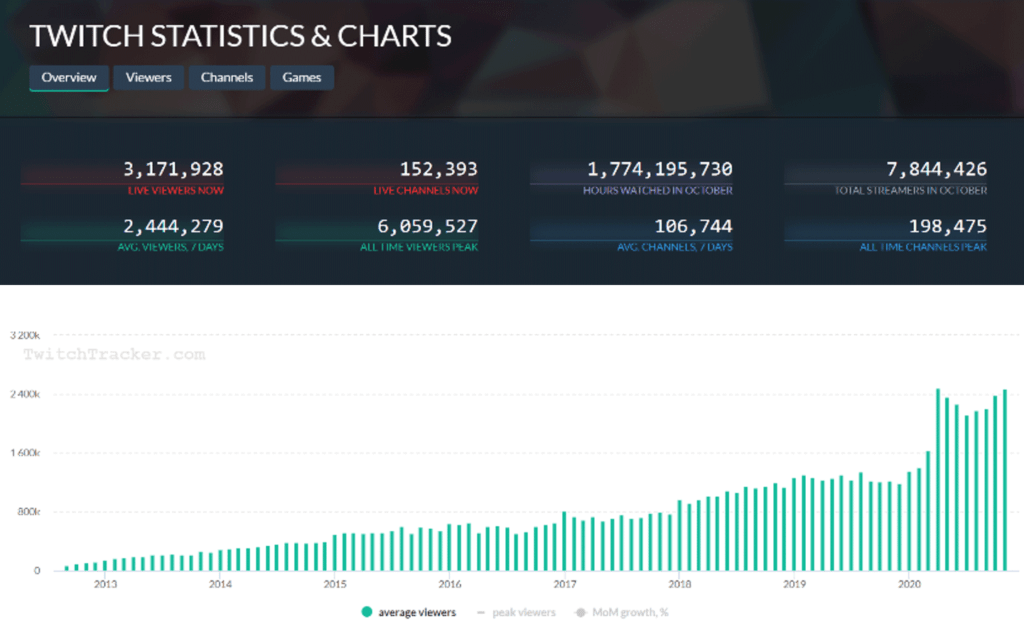
Twitchtracker.com
Twitchtracker.com allows you to view the most watched games and channels which is a really nice bit of data resource for any rankings of popularity.
Twitch might not be a platform you are currently active on or have even thought to be, so hopefully it is a helpful untapped space for your next campaign.
Wikipedia: a goldmine for validating trends
Even though not technically a social media platform, it is one of the largest online communities in the world and is read and edited by billions across the planet every day. As a result of its huge appeal, it’d be an absolute goldmine if you could see the page views of each Wikipedia page, so then you could help validate trends and usage – and fortunately you can!
Pageviews Analysis
You can compare up to 10 pages in one graph, to analyse them against each other. It also has a monthly ranking of the most visited pages where you can spot Netflix shows, celebrities, political names etc. It’s a resource I love to check just to validate and feed ideas of what is popular and what people are looking at.
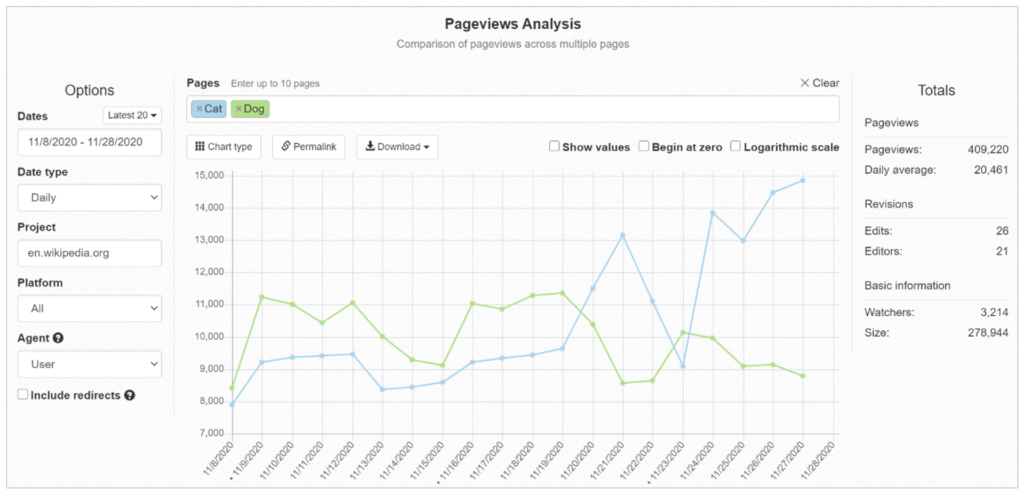
Again, perhaps not an avenue you may have thought to look deeper into previously but certainly one to check in on as your campaign ideas evolve and require validation.
Additional tips
While those are the main social channels and features I use, I’ve also gathered a few more tips to finish off with that you might find useful to keep you in the loop of trending news and social content:
- Talkwalker alerts – get hashtag uses and mentions sent straight to your inbox to monitor activity and trends
- Exploding Topics – a weekly email newsletter to pick out and highlight the latest trends before they take off.
- Content Curated – a monthly newsletter highlighting exceptional content, helping to inspire and inform your future campaigns.
- YouGov Daily – a daily newsletter of top-line data with the first results from the three topical questions they ask the country every morning.
- Feedly – create your own feeds of news with this news aggregator site to keep up with the latest news trends.
- NewsNow – another news aggregator, full of news from sources across the world, highlighting the most read pieces.
- Spotify – music streaming data going back to 2017
Tailored email alerts and hand-picked newsletters are an efficient way to get the information you’re looking for presented to you regularly.
The social media machine has a huge role to play in highlighting important conversations and relevant information that, mined effectively for credible data, can be used to flesh out even just the spark of a campaign idea. We continue to find value in existing and upcoming platforms, always keeping an eye out for new spaces where constructive, expert discussion is being shared.
If you’d like to find out more about how to use social media to jump on trending topics and aid creative campaigns, why not get in touch and see how we can help.